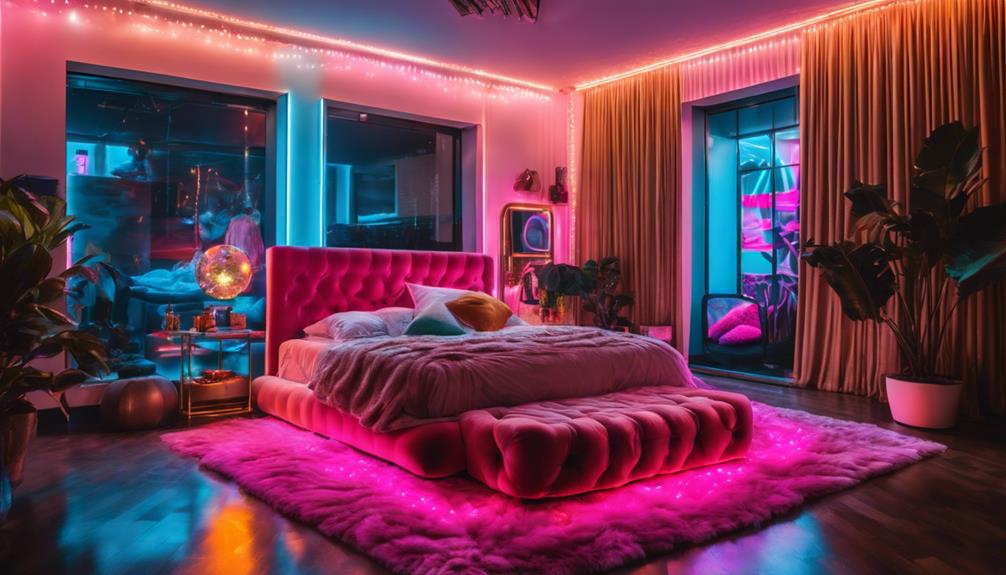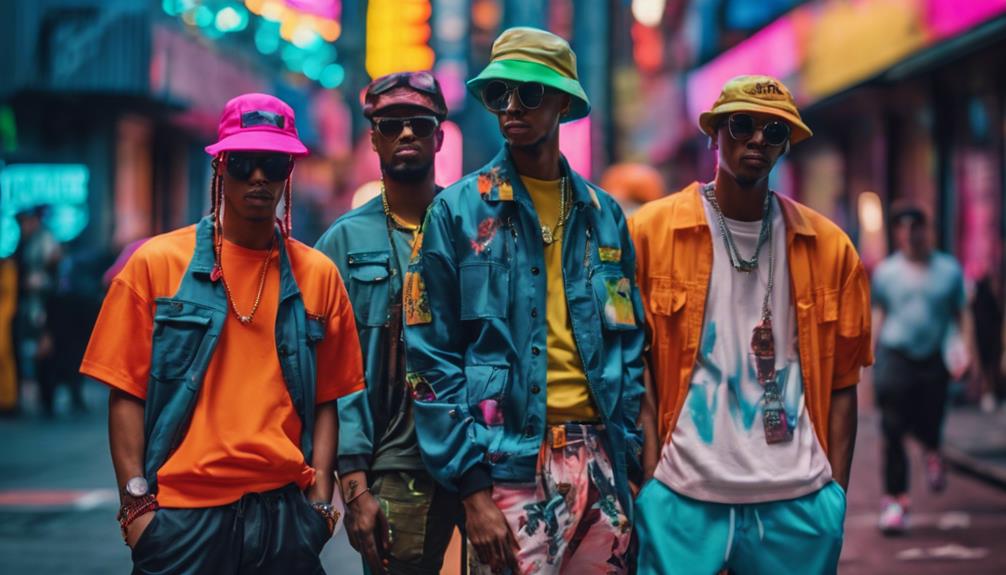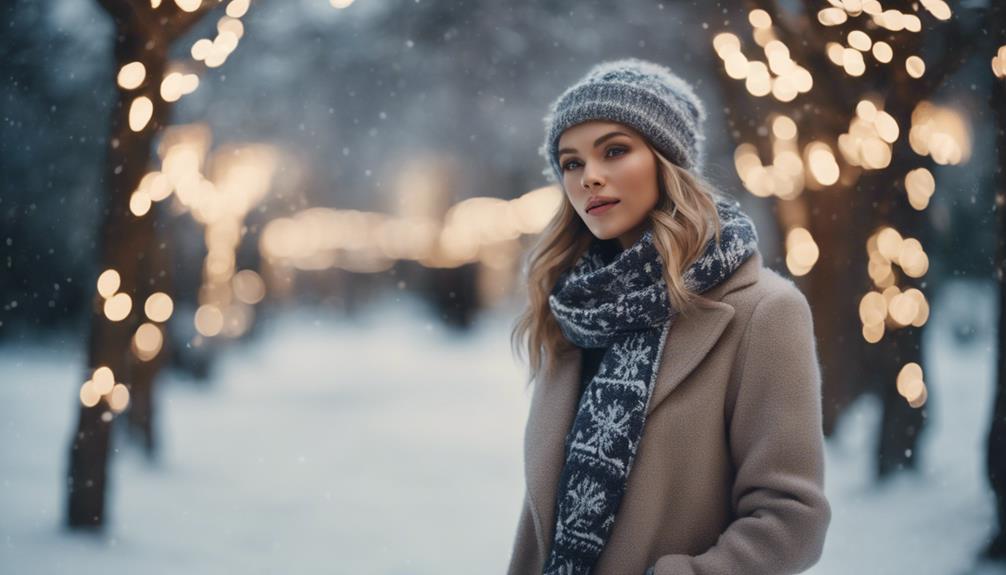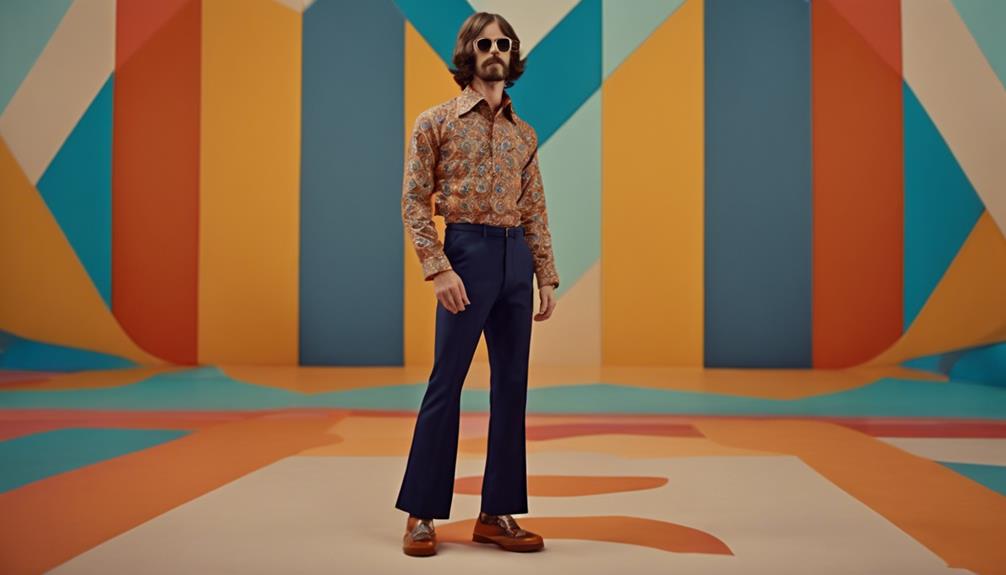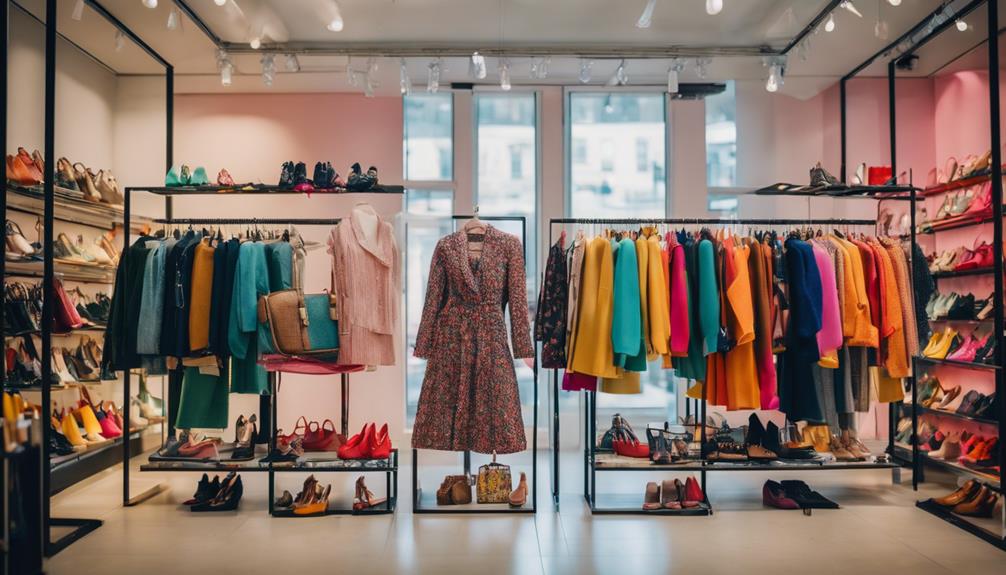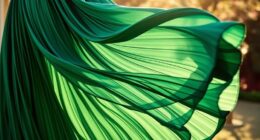Fashion merchandising combines creativity with strategic thinking, playing a crucial role in determining what you choose to wear. You will examine how trends develop and influence consumer behavior, providing valuable insights into setting trends. Modern merchandising focuses on sustainability, helping you appreciate the significance of eco-friendly practices. Additionally, you will gain access to styling tips and shopping guides that will expand your fashion knowledge. By mastering these principles, you will be well-positioned to establish your own place within the industry. The journey through fashion merchandising will equip you with the necessary skills to excel. Stay tuned to learn more about this dynamic industry and its impact on culture!
Key Takeaways
- Understand the historical evolution of fashion to grasp current trends and consumer behavior in merchandising.
- Learn about influential figures and modern icons who shape fashion marketing and consumer perceptions.
- Explore key concepts in fashion merchandising, including trend forecasting, brand identity, and consumer insights.
- Familiarize yourself with sustainability practices and the rise of eco-friendly fashion to meet modern consumer demands.
Origin and historical background of the fashion trend/style
When you explore the origins of fashion trends, you'll notice how historical transformations shaped what we wear today.
Icons and innovators have consistently influenced styles, introducing new concepts that resonate with each generation.
Understanding this evolution helps you appreciate the dynamic nature of fashion merchandising and its impact on consumer choices.
Historical Fashion Transformations
Exploring the origins of fashion merchandising reveals how early 20th-century department stores utilized visual merchandising to enhance customer engagement and transform shopping experiences. This era marked a significant shift in retail, as the rise of ready-to-wear clothing made fashion more accessible to the masses. It moved the focus from luxury haute couture to retail merchandising, responding directly to consumer demand.
After World War II, fashion merchandising emerged as a distinct profession, with educational programs designed to prepare individuals for roles in buying, planning, and marketing. By the 1980s, you witnessed historical transformations in the industry, as branding became essential. Iconic labels emerged, emphasizing brand identity in fashion merchandising and changing how consumers interacted with products.
In the 21st century, digital technology revolutionized the field even further. It allowed brands to analyze data in real-time, creating personalized marketing strategies that catered to evolving consumer preferences. This seamless integration of technology and fashion merchandising has fundamentally reshaped how you experience and engage with fashion today, ensuring that it remains a dynamic and responsive industry.
Fashion Icons and Innovators
Fashion icons and innovators have consistently reshaped the industry, leaving an indelible mark on trends and styles throughout history.
In the early 20th century, figures like Coco Chanel introduced modernist styles that emphasized comfort and practicality, exemplified by the little black dress and Chanel No. 5. Fast forward to 1947, Christian Dior's 'New Look' revolutionized post-war fashion, focusing on femininity with cinched waists and full skirts.
The late 20th century saw the rise of street style, influenced by personalities like Andy Warhol and designers such as Vivienne Westwood, who brought youth culture into mainstream fashion. Subsequently, designers like Alexander McQueen and John Galliano challenged traditional aesthetics with their avant-garde collections, blending theatricality and high fashion.
Today, digital influencers like Chiara Ferragni and Aimee Song are at the forefront of fashion innovation, leveraging social media to democratize style and engage audiences. They've transformed marketing strategies in the fashion world, highlighting the importance of personal branding and connection.
Key Characteristics

When it comes to fashion merchandising, understanding signature patterns and textures sets you apart in the market.
You'll also want to focus on sustainable fabric choices that align with today's eco-conscious consumers.
Signature Patterns and Textures
Signature patterns and textures play an essential role in defining a brand's identity and appealing to consumers. By incorporating signature patterns like florals, stripes, or plaids, you create a recognizable aesthetic that resonates with specific demographics and seasonal trends. These elements not only enhance product appeal but also build brand loyalty in a competitive market.
Textures greatly influence how consumers perceive luxury. Soft velvets and sleek silks elevate the feeling of opulence, while unique textures like distressed denim or embossed leather cater to tactile preferences. When you understand how these textures impact consumer behavior, you can tailor your offerings to meet their desires.
Effective fashion merchandising strategies rely on trend forecasting and market research to pinpoint which signature patterns and textures will drive sales. By analyzing consumer behavior, you can identify what resonates most with your target audience. This insight enables you to craft collections that not only reflect the latest trends but also solidify your brand identity.
Ultimately, the thoughtful integration of signature patterns and textures can differentiate your products, making them more appealing and increasing your chances of success in the fashion industry.
Sustainable Fabric Choices
Selecting sustainable fabrics is essential for creating eco-friendly collections that resonate with today's environmentally-conscious consumers. These fabrics often come from renewable resources, like organic cotton, hemp, and Tencel, which require fewer pesticides and less water than conventional textiles.
Additionally, many sustainable fabrics are biodegradable or recyclable, helping to reduce landfill waste and lessen environmental impact at the end of their life cycle.
Innovations in sustainable textiles include the use of recycled materials, such as transforming PET bottles into polyester. This considerably decreases the demand for virgin resources.
When you choose sustainable fabrics, you also support ethical practices, ensuring fair labor conditions and uplifting local communities throughout the supply chain.
Certifications like the Global Organic Textile Standard (GOTS) and OEKO-TEX® play an essential role in this movement. They guarantee that sustainable fabrics meet stringent environmental and social criteria, providing transparency that consumers appreciate.
Timeless Fashion Staples
Timeless fashion staples embody enduring appeal, offering versatile pieces that seamlessly shift across various occasions and trends. Classic pieces like a white button-up shirt, tailored blazer, and little black dress are fundamental in every wardrobe. These staples maintain relevance, transcending seasonal trends and fashion eras.
High-quality materials and craftsmanship are vital characteristics of timeless fashion staples, guaranteeing durability and a polished appearance that lasts. By choosing these pieces, you invest in items that won't go out of style anytime soon. Neutral colors such as black, white, beige, and navy dominate these staples, making it easy to coordinate your outfits without hassle.
Moreover, embracing timeless fashion promotes sustainability. When you opt for versatile pieces, you reduce the need for fast fashion consumption, leading to a more responsible approach to dressing. By curating a wardrobe filled with timeless staples, you not only enhance your style but also contribute to a more sustainable fashion industry.
Incorporating timeless fashion staples into your collection secures you're always dressed appropriately, regardless of the occasion. So, focus on investing in quality pieces that offer both style and sustainability.
Modern Interpretation

In today's fashion merchandising, you're likely noticing a strong emphasis on sustainable innovations and luxury labels that prioritize eco-friendly practices.
Fashion icons of the era are also playing a significant role in shaping these trends, influencing how consumers view and engage with brands.
As you explore these topics, consider how they reflect a modern interpretation of style that balances tradition with contemporary values.
Sustainable Fashion Innovations
Sustainable fashion innovations are transforming the industry by prioritizing eco-friendly materials and ethical production practices, making it easier for you to make conscious choices. Brands are increasingly using organic cotton and recycled polyester, which greatly reduce carbon footprints and water usage.
You'll find that many companies are adopting circular fashion models, designing products for longevity, repairability, and recyclability, which promotes resource efficiency and minimizes waste.
Technology plays an essential role, too. With advancements like 3D printing and digital sampling, brands can reduce waste during the design phase and streamline production processes.
Furthermore, a growing number of fashion companies are implementing transparent supply chains, ensuring ethical labor practices and sustainable sourcing. This transparency allows you to make informed purchasing decisions that align with your values.
The global sustainable fashion market is projected to reach $8.25 billion by 2023, reflecting a rising consumer demand for environmentally conscious and ethical fashion choices.
As you embrace sustainable fashion, you contribute to a movement that prioritizes environmental consciousness and social responsibility, making a positive impact with every purchase you make.
Sustainable Luxury Fashion Labels
The shift towards eco-conscious choices has paved the way for sustainable luxury fashion labels that prioritize ethical production and innovative materials. Brands like Stella McCartney are leading this movement, using vegan leather and recycled fabrics to set new standards for transparency and environmental responsibility. As a result, the sustainable luxury market is projected to hit $8.25 billion by 2025, reflecting a growing consumer preference for brands that combine quality with ethical practices.
These labels embrace circular fashion principles, implementing take-back programs and resale platforms that reduce waste and extend product lifecycles. This approach resonates with the eco-conscious values of today's shoppers, who increasingly seek to align their purchases with their principles.
Digital marketing plays an essential role in this evolution, allowing sustainable luxury brands to share their stories and values directly with consumers. Through social media and targeted campaigns, they create a loyal customer base that prioritizes responsible consumption.
Fashion Icons of the Era
Modern fashion icons like Rihanna and Harry Styles are reshaping the industry by blending gender norms and pushing the boundaries of personal style. They challenge traditional expectations, demonstrating that fashion isn't confined to specific genders. Alongside them, designers like Virgil Abloh have merged streetwear with luxury fashion, making high-end looks accessible and relevant for everyday life.
Social media influencers, such as Chiara Ferragni and Aimee Song, have also transformed the landscape, using platforms like Instagram to connect with millions and set trends. Supermodels like Bella and Gigi Hadid epitomize this influence, dominating runways and collaborating with top brands, showcasing the powerful role of supermodels in modern marketing.
Moreover, today's fashion icons are increasingly prioritizing sustainability. Celebrities like Emma Watson advocate for eco-friendly fashion choices and support brands that embrace ethical practices. This shift towards sustainability not only reflects changing consumer values but also pushes the entire industry to adopt more responsible methods.
Styling Tips

When it comes to styling, mastering the classic white button-up shirt can elevate your wardrobe instantly.
You can create versatile looks by layering and experimenting with color coordination techniques that suit your personal style.
Let's explore how these elements can transform your outfits and enhance your fashion game.
Classic White Button-Up Shirt
A classic white button-up shirt effortlessly transforms your outfit, making it a must-have for any wardrobe. This versatile wardrobe staple can be styled in countless ways, suitable for both casual outings and formal events.
Pair your white button-up with tailored trousers for a polished, professional look that's perfect for the office. If you're aiming for a more relaxed vibe, try knotting the shirt at the waist; it adds a trendy touch that's great for brunch or a night out.
When it comes to fabric, opt for breathable materials like cotton or linen, especially in warmer weather. These fabrics not only guarantee comfort but also enhance the overall aesthetic of your outfit.
Elevate the simplicity of the classic white button-up shirt by accessorizing with statement jewelry or a bold belt. These additions allow you to express your personal style while maintaining the shirt's timeless elegance.
Layering Techniques for Versatility
Building on the classic white button-up shirt, mastering layering techniques can enhance your outfit's versatility and adapt it to various occasions.
Layering adds dimension to your styling, allowing you to shift effortlessly from casual to formal settings. Start by playing with varying lengths and textures; for example, pair a cropped jacket with a longer tunic to create visual interest.
When choosing fabrics, opt for lightweight materials like cotton or linen for your base layers. These options offer breathability, while heavier outer layers like knits or coats provide warmth.
Accessories play an essential role in your layering game, too. Quick additions like scarves or vests can transform an outfit instantly, making it easy to adjust to changing temperatures.
Don't shy away from experimenting with colors and patterns. Color blocking and unique combinations can reflect your personal style while ensuring a cohesive look.
Color Coordination Techniques
Mastering color coordination techniques can elevate your outfits, guaranteeing they're not only stylish but also harmonious and eye-catching.
Understanding color theory is essential; it involves the color wheel, which helps you choose colors that work well together. For instance, complementary colors—those opposite each other on the wheel—create vibrant, striking looks that grab attention. Alternatively, you can opt for analogous colors, which sit next to each other on the wheel, offering a more subtle and cohesive appearance.
Incorporating seasonal color palettes, like the Pantone Color of the Year, can also enhance your style by aligning with current trends.
When coordinating your colors, remember the 60-30-10 rule: use 60% of a dominant color, 30% of a secondary color, and 10% of an accent color. This approach guarantees a balanced and visually appealing ensemble.
Ultimately, mastering these color coordination techniques allows you to create harmonious color schemes that reflect your personality while keeping your wardrobe fresh and engaging.
Shopping Guide

Steering through the world of fashion shopping requires knowing key trends and understanding your personal style to make informed choices. As a savvy shopper, you'll benefit by recognizing the roles of buyers, product developers, and marketing professionals. These individuals shape the product journey from design to purchase, ensuring that what you see in stores aligns with current consumer behavior.
When you shop, pay attention to merchandising strategies that reflect brand identity. Knowing how pricing strategies work can help you identify value and quality, allowing you to make smarter purchases. Additionally, experience in retail environments, whether through internships or entry-level positions, can enhance your understanding of how products are displayed and marketed.
Keep an eye on trends to stay ahead, but don't forget to assess what truly fits your style. Networking through school programs or industry events can also provide insights into effective shopping practices. By combining your personal taste with knowledge of the fashion industry, you can navigate your shopping experiences with confidence, ensuring that each purchase aligns with both current trends and your unique style.
Upcycling Old Garments

When you think about upcycling old garments, consider how fabric swaps and exchanges can breathe new life into your wardrobe.
You can also explore personalized embellishment techniques to add your unique touch to these transformed pieces.
This creative approach not only reduces waste but also allows you to express your style in an eco-friendly way.
Fabric Swaps and Exchanges
Participating in fabric swaps and exchanges not only promotes sustainable fashion but also allows you to breathe new life into old garments while connecting with others in your community. By trading unwanted clothes, you help reduce textile waste and support upcycling efforts, extending the lifecycle of fashion items. These events foster a circular economy, where resources are reused instead of discarded.
When you join a fabric swap, you'll discover unique materials that can spark your creativity in fashion design. You won't need to spend money; instead, you'll gain fresh inspiration from fellow participants enthusiastic to share ideas and techniques. As you engage in these exchanges, you'll build community connections that enhance your experience and broaden your understanding of sustainable practices.
Attending regular fabric swap events not only provides you with new-to-you garments but also allows you to be part of a collective movement toward more responsible fashion choices. Embracing this approach can greatly mitigate the environmental impact of the fashion industry, proving that fashion can be both creative and considerate.
Personalized Embellishment Techniques
Personalized embellishment techniques like embroidery and fabric painting can breathe new life into old garments, allowing you to create unique pieces that reflect your individual style.
By embracing upcycling, you not only reduce textile waste but also align with the growing demand for sustainable fashion. This approach encourages creativity and individuality, turning outdated clothing into trendy statements.
You can explore various techniques such as patchwork, tie-dye, or bleach distressing to give your wardrobe a fresh twist. Adding beads or sequins can elevate vintage pieces, making them one-of-a-kind treasures. The beauty of these personalized embellishment techniques lies in their ability to transform the mundane into something remarkable.
Participating in workshops or following online tutorials can enhance your skills and immerse you in the DIY culture. This hands-on experience empowers you to take control of your fashion choices, making the industry more accessible.
As you experiment and innovate, you'll not only showcase your personality but also contribute to a sustainable future in fashion merchandising. So, grab those old garments and let your creativity shine!
Cultural Impact

Fashion in film and TV shapes what you wear and how you express yourself, often reflecting broader cultural themes.
Similarly, fashion and political activism intersect, turning clothing into powerful symbols of movements and beliefs.
Fashion in Film and TV
The influence of fashion in film and television dramatically shapes cultural trends, transforming iconic outfits into must-have items for consumers. When you watch shows like 'Sex and the City' or films like 'The Devil Wears Prada,' you can't help but notice how these styles impact consumer fashion.
Costume designers play an essential role, working closely with directors to craft visual narratives that resonate with current fashion trends. For instance, 'Euphoria' has revolutionized streetwear, sparking bold aesthetics that fans keenly adopt.
The correlation between on-screen fashion and consumer interest is significant. After popular films release, Google searches for fashion-related keywords often surge, indicating heightened consumer curiosity. Iconic outfits can lead to remarkable sales growth; remember the 'Carrie' dress from 'Sex and the City'? It sold out within hours of its debut, showcasing the immediate impact of fashion in media.
Moreover, brands have tapped into product placement, recognizing its potential to boost brand recognition by up to 20%. This strategy not only enhances storytelling but also drives sales, proving that the intersection of fashion and film is a powerful force in contemporary culture.
Fashion and Political Activism
Clothing has become a powerful tool for political activism, allowing individuals and brands to express their beliefs and drive social change. Throughout history, fashion has played a significant role in movements, like the 1960s Civil Rights Movement, where clothing symbolized resistance.
Today, fashion brands actively engage in political activism, especially in movements like 'Black Lives Matter,' using their platforms to advocate for social issues through impactful design.
Sustainability is also a key focus, with brands such as Patagonia and designers like Stella McCartney promoting ethical practices as a response to climate change. These efforts resonate with consumers who prioritize eco-friendly choices.
Events like the Met Gala serve as high-profile stages for political statements, where celebrities use fashion to highlight pressing social issues. For instance, Alexander McQueen's designs have tackled themes of gender and identity, sparking conversations that extend beyond the red carpet.
Moreover, social media amplifies this activism, connecting movements like 'Fashion for Future' with younger audiences enthusiastic to discuss sustainability and ethical consumption.
Frequently Asked Questions
What Does Fashion Merchandising Teach You?
Fashion merchandising teaches you how to navigate the fashion industry, covering design, marketing, and consumer behavior. You'll gain practical skills, understand market trends, and develop a portfolio showcasing your learning and experiences.
How to Learn About Fashion Business?
To learn about the fashion business, immerse yourself in industry trends, take relevant courses, gain hands-on experience through internships, and network with professionals. Stay curious, explore resources, and engage in continuous learning to refine your skills.
What Are the 5 R's of Fashion Merchandising?
The 5 R's of fashion merchandising are Right Product, Right Price, Right Place, Right Time, and Right Quantity. These principles help you meet consumer demand effectively and maximize your sales potential in the fashion industry.
What Is Fashion Business Merchandising?
Fashion business merchandising involves managing the entire process of bringing products from design to consumer purchase. You'll need to understand trends, consumer behavior, and effective marketing strategies to succeed in this dynamic industry.
How Does Fashion Merchandising Contribute to the Earnings of Fashion Designers?
Fashion merchandising plays a crucial role in the earnings of fashion designers. By analyzing market trends and consumer behavior, fashion merchandisers can provide valuable fashion designer salary insights. This helps designers create collections that resonate with their target audience, ultimately boosting sales and increasing their earning potential.
Conclusion
To sum up, diving into fashion merchandising opens up a world of creativity and opportunity.
You've explored its rich history, key characteristics, and modern interpretations, all while gaining valuable styling tips and shopping insights.
Don't forget the importance of upcycling old garments, which not only promotes sustainability but also adds a unique flair to your wardrobe.
Embrace the cultural impact of fashion and let your personal style shine through as you navigate this vibrant industry!

